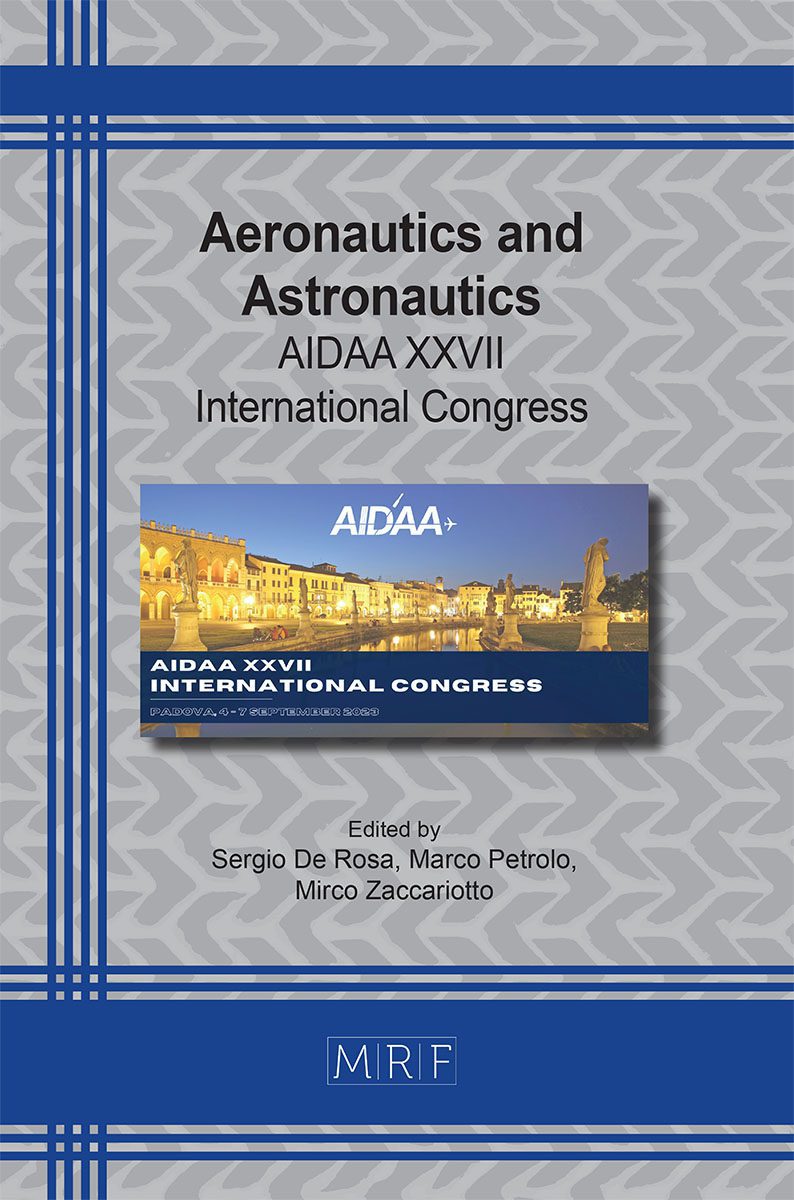RANS transition model predictions on hypersonic three-dimensional forebody configuration
Luigi Cutrone, Antonio Schettino
download PDFAbstract. Future space transportation systems will heavily rely on predicting and understanding Boundary Layer Transition (BLT) during atmospheric entry, especially in the hypersonic phase. Several models, compatible with RANS solvers, have yet been proposed, but not validated in the hypersonic regime. This paper focuses on evaluating prediction capabilities for such models on complex 3D geometries, using the International Boundary Layer Transition (BOLT) Flight Experiment as a test case.
Keywords
Laminar-to-Turbulent Transition, CFD, Hypersonic Flows
Published online 11/1/2023, 4 pages
Copyright © 2023 by the author(s)
Published under license by Materials Research Forum LLC., Millersville PA, USA
Citation: Luigi Cutrone, Antonio Schettino, RANS transition model predictions on hypersonic three-dimensional forebody configuration, Materials Research Proceedings, Vol. 37, pp 166-169, 2023
DOI: https://doi.org/10.21741/9781644902813-36
The article was published as article 36 of the book Aeronautics and Astronautics
![]() Content from this work may be used under the terms of the Creative Commons Attribution 3.0 license. Any further distribution of this work must maintain attribution to the author(s) and the title of the work, journal citation and DOI.
Content from this work may be used under the terms of the Creative Commons Attribution 3.0 license. Any further distribution of this work must maintain attribution to the author(s) and the title of the work, journal citation and DOI.
References
[1] Steelant, J., Dick, E., Modelling of Bypass Transition with Conditioned Navier–Stokes Equations Coupled to An Intermittency Transport Equation. J. Num. Meth. Fluids, 23:193-220. https://doi.org/10.1002/(SICI)1097-0363(19960815)23:3%3C193::AID-FLD415%3E3.0.CO;2-2
[2] Suzen, Y. B., and Huang, P. G., Modeling of Flow Transition Using an Intermittency Transport Equation. ASME. J. Fluids Eng. June 2000; 122(2): 273–284. https://doi.org/10.1115/1.483255
[3] R. B. Langtry and F. R. Menter. Correlation-Based Transition Modeling for Unstructured Parallelized Computational Fluid Dynamics Codes. AIAA Journal. 47(12), 2009, pp. 2894–2906. https://doi.org/10.2514/1.42362
[4] Menter, F. R., Smirnov, P. E., Liu, T., and Avancha, R., A One-Equation Local Correlation-Based Transition Model, Flow, Turbulence and Combustion, Vol. 95, No. 4, 2015, pp. 583–619. https://doi.org/10.1007/s10494-015-9622-4
[5] Menter, F. R., Matyushenko, A., Lechner, R., Stabnikov, A., and Garbaruk, A., An Algebraic LCTM Model for Laminar–Turbulent Transition Prediction, Flow, Turb. Comb., Vol. 109, No. 4, 2022, pp. 841–869. https://doi.org/10.1007/s10494-022-00336-8
[6] Liu, Z., Lu, Y., Li, J., and Yan, C. Local correlation-based transition model for high-speed flows. AIAA Journal, 60(3):1365–1381, 2022. https://doi.org/10.2514/1.J060994
[7] Berridge, D. C., McKiernan, G., Wadhams, T. P., Holden, M., Wheaton, B. M., Wolf, T. D., and Schneider, S. P., Hypersonic Ground Tests in Support of the Boundary Layer Transition (BOLT) Flight Experiment, Fluid Dynamics Conference, 2018, p. 2893. https://doi.org/10.2514/6.2018-2893
[8] Menter, F. R., “Two-Equation Eddy-Viscosity Turbulence Models for Engineering Applications,” AIAA Journal, Vol. 32, No. 8, August 1994, pp. 1598-1605. https://doi.org/10.2514/3.12149
[9] Infante, G. M., Cutrone, L., Schettino, A., Numerical methods for laminar/turbulent transition prediction in Hypersonic regime, ESA FAR conference, 2020.
[10] J. I. Cardesa, G. Delattre Comparison of RANS transition model predictions on hypersonic three-dimensional forebody configurations 57th 3AF International Conference on Applied Aerodynamics 29-31 March 2023, Bordeaux – France































